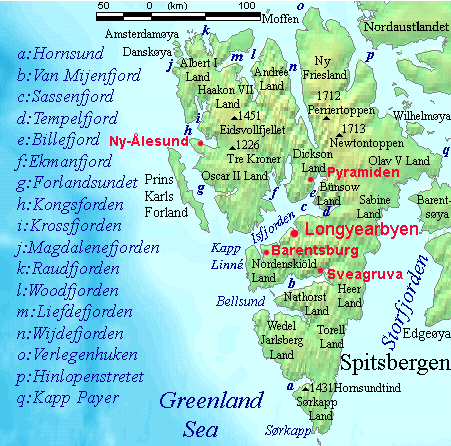|
Tschermakfjellet
Tschermakfjellet is a mountain in Dickson Land at Spitsbergen, Svalbard. It has a height of 422 m.a.s.l., and is located between the valley of Sauriedalen and Kongressfjellet. The mountain is named after Austrian mineralogist Gustav Tschermak von Seysenegg. Geology The mountain has given name to the Triassic Tschermakfjellet Formation of the Kapp Toscana Group, consisting of sandstones and silty shales. References Mountains of Spitsbergen {{Spitsbergen-mountain-stub ... [...More Info...] [...Related Items...] OR: [Wikipedia] [Google] [Baidu] |
Tschermakfjellet Formation
The Tschermakfjellet Formation is a geological formation in Svalbard, Norway, a subunit of the Kapp Toscana Group. The formation dates to the Late Triassic (Carnian, early Carnian). Description It is named after the mountain of Tschermakfjellet in Dickson Land at Spitsbergen, while its type section is found at Botneheia in Nordenskiöld Land. The formation has provided fossils of invertebrates and of an indeterminate Pistosauridae, pistosaurid. at Fossilworks.org References Bibliography * *Further reading * H. J. Campbell. 1994. The Triassic bivalves ''Daonella'' and ''Halobia'' in ...[...More Info...] [...Related Items...] OR: [Wikipedia] [Google] [Baidu] |
Kapp Toscana Group
The Kapp Toscana Group is a geologic group in Svalbard and Jan Mayen in the Barents Sea, Norway. Description The group dates back to the Late Triassic, and comprises the rock formations of Tschermakfjellet, De Geerdalen and Wilhelmøya. The group is named from the headland of Kapp Toscana at the southern side of Van Keulenfjorden in Wedel Jarlsberg Land at Spitsbergen, Svalbard. The thickness of the group varies from of deltaic shales with interbedded sandstone Sandstone is a Clastic rock#Sedimentary clastic rocks, clastic sedimentary rock composed mainly of grain size, sand-sized (0.0625 to 2 mm) silicate mineral, silicate grains, Cementation (geology), cemented together by another mineral. Sand ...s. The Kapp Toscana Group was initially defined as a formation, but has later become a group. The type section was taken from Kapp Toscana at Van Keulenfjorden, where the thickness of the unit was , while its two members Tschermakfjellet and De Geerdalen had type se ... [...More Info...] [...Related Items...] OR: [Wikipedia] [Google] [Baidu] |
Sauriedalen
Sauriedalen is a valley in Dickson Land at Spitsbergen, Svalbard. It has a length of about sixteen kilometers, extending from Njordfjellet and Gyntflya to Tschermakfjellet. The valley is named from fossil Triassic reptiles (sauria Sauria is the clade of diapsids containing the most recent common ancestor of Archosauria (which includes crocodilians and birds) and Lepidosauria (which includes squamates and the tuatara), and all its descendants. Since most molecular phyl ...), found in the nearby Saurieberget. References Valleys of Spitsbergen {{Spitsbergen-geo-stub ... [...More Info...] [...Related Items...] OR: [Wikipedia] [Google] [Baidu] |
Kongressfjellet
Kongressfjellet is a mountain in Dickson Land at Spitsbergen, Svalbard. It has a height of 605 m.a.s.l., and is located between the valleys of Idodalen (north) and Sauriedalen (east), and the mountain of Tschermakfjellet (south). References Mountains of Spitsbergen {{Spitsbergen-mountain-stub ... [...More Info...] [...Related Items...] OR: [Wikipedia] [Google] [Baidu] |
Gustav Tschermak 1906 Charlotte Mandl
Gustav, Gustaf or Gustave may refer to: *Gustav (name), a male given name of Old Swedish origin Art, entertainment, and media * ''Primeval'' (film), a 2007 American horror film * ''Gustav'' (film series), a Hungarian series of animated short cartoons * Gustav (''Zoids''), a transportation mecha in the ''Zoids'' fictional universe *Gustav, a character in ''Sesamstraße'' *Monsieur Gustav H., a leading character in ''The Grand Budapest Hotel'' * Gustaf, an American art punk band from Brooklyn, New York. Weapons *Carl Gustav recoilless rifle, dubbed "the Gustav" by US soldiers *Schwerer Gustav, 800-mm German siege cannon used during World War II Other uses *Gustav (pigeon), a pigeon of the RAF pigeon service in WWII *Gustave (crocodile), a large male Nile crocodile in Burundi *Gustave, South Dakota *Hurricane Gustav (other), a name used for several tropical cyclones and storms *Gustav, a streetwear clothing brand See also *Gustav of Sweden (other) *Gustav Adolf (d ... [...More Info...] [...Related Items...] OR: [Wikipedia] [Google] [Baidu] |
Dickson Land
Dickson Land is a land area between Isfjorden and Wijdefjorden at Spitsbergen, Svalbard Svalbard ( , ), previously known as Spitsbergen or Spitzbergen, is a Norway, Norwegian archipelago that lies at the convergence of the Arctic Ocean with the Atlantic Ocean. North of continental Europe, mainland Europe, it lies about midway be .... It forms a peninsula between the Isfjorden branches Billefjorden and Dicksonfjorden. Dickson Land is named after Oscar Dickson. References Geography of Svalbard Spitsbergen {{Spitsbergen-geo-stub ... [...More Info...] [...Related Items...] OR: [Wikipedia] [Google] [Baidu] |
Spitsbergen
Spitsbergen (; formerly known as West Spitsbergen; Norwegian language, Norwegian: ''Vest Spitsbergen'' or ''Vestspitsbergen'' , also sometimes spelled Spitzbergen) is the largest and the only permanently populated island of the Svalbard archipelago in northern Norway in the Arctic Ocean. Constituting the westernmost bulk of the archipelago, it borders the Arctic Ocean, the Norwegian Sea and the Greenland Sea. Spitsbergen covers an area of , making it the largest island in Norway and the List of islands by area, 36th largest in the world. The administrative centre is Longyearbyen. Other settlements, in addition to research outposts, are the mining community of Barentsburg, the research community of Ny-Ålesund, and the mining outpost of Sveagruva. Spitsbergen was covered in of ice in 1999, which was approximately 58.5% of the island's total area. The island was first used as a whaling base in the 17th and 18th centuries, after which it was abandoned. Coal mining started at the e ... [...More Info...] [...Related Items...] OR: [Wikipedia] [Google] [Baidu] |
Svalbard
Svalbard ( , ), previously known as Spitsbergen or Spitzbergen, is a Norway, Norwegian archipelago that lies at the convergence of the Arctic Ocean with the Atlantic Ocean. North of continental Europe, mainland Europe, it lies about midway between the northern coast of Norway and the North Pole. The islands of the group range from 74th parallel north, 74° to 81st parallel north, 81° north latitude, and from 10th meridian east, 10° to 35th meridian east, 35° east longitude. The largest island is Spitsbergen (37,673 km2), followed in size by Nordaustlandet (14,443 km2), (5,073 km2), and Barentsøya (1,288 km2). Bear Island (Norway), Bjørnøya or Bear Island (178 km2) is the most southerly island in the territory, situated some 147 km south of Spitsbergen. Other small islands in the group include Hopen (Svalbard), Hopen to the southeast of Edgeøya, Kongsøya and Svenskøya in the east, and Kvitøya to the northeast. The largest settlement is Longyearbyen, situated in Isfjor ... [...More Info...] [...Related Items...] OR: [Wikipedia] [Google] [Baidu] |
Gustav Tschermak Von Seysenegg
Gustav Tschermak von Seysenegg (19 April 1836 – 24 May 1927) was an Austrian mineralogist. Biography He was born in Litovel, Moravia, and studied at the University of Vienna, where he obtained a teaching degree. He studied mineralogy at Heidelberg and Tübingen and obtained a PhD. He returned to Vienna as a lecturer in mineralogy and chemistry and, in 1862 was appointed second vice curator of the Imperial Mineralogical Cabinet, becoming director in 1868. He resigned as director in 1877. He was also professor of petrography at the University of Vienna. He was appointed professor in 1873 and a member of the Imperial Academy of Sciences, a member of the American Philosophical Society in 1882, and a member of the Royal Swedish Academy of Sciences in 1905. He died in 1927, aged 91. Work He did useful work on many minerals and on meteorites. The mineral tschermakite is named in his honour. In 1871 he established the ''Mineralogische Mitteilungen'' (Mineralogical Reports), publish ... [...More Info...] [...Related Items...] OR: [Wikipedia] [Google] [Baidu] |
Norwegian Polar Institute
The Norwegian Polar Institute (NPI; ) is Norway's central governmental institution for scientific research, mapping and environmental monitoring in the Arctic and the Antarctic. The NPI is a directorate under Norway's Ministry of Climate and Environment (Norway), Ministry of Climate and Environment. The institute advises Norwegian authorities on matters concerning polar environmental management and is the official environmental management body for Norwegian activities in Antarctica. Activities The institute's activities are focused on environmental research and management in the polar regions. The NPI's researchers investigate biodiversity, climate and environmental toxins in the Arctic and Antarctic, and in this context the institute equips and organizes large-scale expeditions to both polar regions. The institute contributes to national and international climate work, and is an active contact point for the international scientific community. The institute collects and analyses ... [...More Info...] [...Related Items...] OR: [Wikipedia] [Google] [Baidu] |
Triassic
The Triassic ( ; sometimes symbolized 🝈) is a geologic period and system which spans 50.5 million years from the end of the Permian Period 251.902 million years ago ( Mya), to the beginning of the Jurassic Period 201.4 Mya. The Triassic is the first and shortest period of the Mesozoic Era and the seventh period of the Phanerozoic Eon. Both the start and end of the period are marked by major extinction events. The Triassic Period is subdivided into three epochs: Early Triassic, Middle Triassic and Late Triassic. The Triassic began in the wake of the Permian–Triassic extinction event, which left the Earth's biosphere impoverished; it was well into the middle of the Triassic before life recovered its former diversity. Three categories of organisms can be distinguished in the Triassic record: survivors from the extinction event, new groups that flourished briefly, and other new groups that went on to dominate the Mesozoic Era. Reptiles, especially archosaurs, were the ... [...More Info...] [...Related Items...] OR: [Wikipedia] [Google] [Baidu] |
Geological Society Of London
The Geological Society of London, known commonly as the Geological Society, is a learned society based in the United Kingdom. It is the oldest national geological society in the world and the largest in Europe, with more than 12,000 Fellows. Fellows are entitled to the postnominal FGS (Fellow of the Geological Society), over 2,000 of whom are Chartered Geologists (CGeol). The Society is a registered charity, no. 210161. It is also a member of the Science Council, and is licensed to award Chartered Scientist to qualifying members. The mission of the society is: "Making geologists acquainted with each other, stimulating their zeal, inducing them to adopt one nomenclature, facilitating the communication of new facts and ascertaining what is known in their science and what remains to be discovered". History The Society was founded on 13 November 1807 at the Freemasons' Tavern, Great Queen Street, in the Covent Garden district of London. It was partly the outcome of a previou ... [...More Info...] [...Related Items...] OR: [Wikipedia] [Google] [Baidu] |






